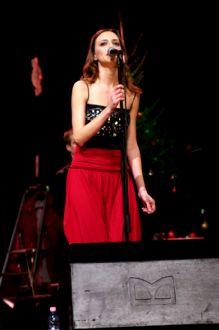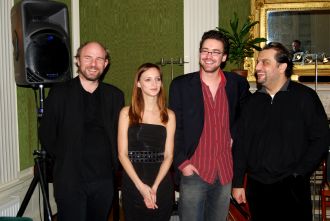Ági Szalóki, Hungarian Cultural Centre, London, 16 January 2008
27. 1. 2008 | Rubriky: Articles,Live reviews
 [by Ken Hunt, London] Hungary is one of Europe’s most productive hothouses for truly revelatory female singers. Once upon a time in Western Europe Márta Sebestyén was all we knew of Hungarian singers. She was our Hungarian sun and moon, earth and horizon. Mind you, starting at the top was not necessarily a bad thing. But it was only getting the chance to see her fly vocally in concert that it truly hit home how world-class a singer she was. In my experience, it is in the live situation that Hungarian music truly reveals its depth and its heights. That applies to most music with a living, beating heart. Despite the generational gap and the apparent differences in their music and approaches, Sebestyén Márta and Szalóki Ági are names fit to speak in the same breath.
[by Ken Hunt, London] Hungary is one of Europe’s most productive hothouses for truly revelatory female singers. Once upon a time in Western Europe Márta Sebestyén was all we knew of Hungarian singers. She was our Hungarian sun and moon, earth and horizon. Mind you, starting at the top was not necessarily a bad thing. But it was only getting the chance to see her fly vocally in concert that it truly hit home how world-class a singer she was. In my experience, it is in the live situation that Hungarian music truly reveals its depth and its heights. That applies to most music with a living, beating heart. Despite the generational gap and the apparent differences in their music and approaches, Sebestyén Márta and Szalóki Ági are names fit to speak in the same breath.
With the political changes of the late 1980s and early 1990s, it became possible to appraise the Hungarian music scene more accurately, more objectively. Hearing a woman with such a distinctive voice as Irén Lovász led to seeking out Szilvia Bognár, Bea Palya and Ági Szalóki. And later Nóri Kovács. Their music opened up new vistas of song. In early 2006 while working on assignments in Hungary’s capital, Budapest, whilst engrossed in research and drowning in dictionaries and booklore, my host slid a striking new voice under my guard. Losing a battle against the angels of the devilish Magyar language was compensated for. The Hungarian folk-jazz of Ági Szalóki’s second solo album Hallgató / Lament (2005) utterly derailed my concentration. That is why two years on, I find myself seeing her in London, not singing with Besh o droM, Makám or Ökrös but fronting her own band. To find myself seeing her, not on some massive stage or singing at London’s Pulse Festival with Besh o droM, but in the genteel setting of the Hungarian Cultural Centre (HCC) in London’s Covent Garden district is a dream. What a difference two years make!
 More salon than venue, the HCC is intimate. Skilled Hungarians can probably sardine, sorry, sit 50 or 60 people and a side-plate of neck-craning snappers into the room. It is therefore also intimate in the sense of small. So, to finally see Ági Szalóki sing in such surroundings had to be a rare privilege. It was different, not like her albums. She came with a stripped-down, three-piece version of her band – József Barcza Horváth on double-bass and two electric guitarists, Gábor Juhász on Fender Stratocaster and Dávid Lamm on a Heritage model. (The Heritage is a Gibson splinter firm out of Kalamazoo, Michigan, I googled later.) This salon soirée line-up heightened the intimacy inordinately. The room also suited her petite, waif-like physicality and her voice admirably. Hearing her sing without a microphone is a priority on my Hungarian wish list.
More salon than venue, the HCC is intimate. Skilled Hungarians can probably sardine, sorry, sit 50 or 60 people and a side-plate of neck-craning snappers into the room. It is therefore also intimate in the sense of small. So, to finally see Ági Szalóki sing in such surroundings had to be a rare privilege. It was different, not like her albums. She came with a stripped-down, three-piece version of her band – József Barcza Horváth on double-bass and two electric guitarists, Gábor Juhász on Fender Stratocaster and Dávid Lamm on a Heritage model. (The Heritage is a Gibson splinter firm out of Kalamazoo, Michigan, I googled later.) This salon soirée line-up heightened the intimacy inordinately. The room also suited her petite, waif-like physicality and her voice admirably. Hearing her sing without a microphone is a priority on my Hungarian wish list.
Despite having gigged as featured or guest vocalist with Besh o droM, Makám and Ökrös or having played on stages like those of Budapest’s Szigetfesztivál, the Théâtre de la Ville in Paris, the Montreal and Ottawa Jazz Festivals and Glasto (that’s the Glastonbury Festival for any reader who isn’t a music journalist) and London’s Barbican Centre, she considers herself a népdalénekes – ‘folk singer’ – and is proud to label herself that way on her business card. That she chooses népdalénekes as her job description speaks volumes. In that respect she is like Szilvia Bognár – one of the three singers along with Ágnes Herczku on Szájról szájra (‘From Mouth To Mouth’). Like Szilvia Bognár, her business card also says népdalénekes. Folk does not have to be a dirty word and népdalénekes testifies to the power and cachet of folk music in the Hungarian belief system – something I wholeheartedly approve of myself.
In the HCC programme booklet the evening was billed lumpenly as “Ethno Jazz”. Partway through, she offered the better title of “My Favourite Songs” as an alternative before launching into a fiery Jewish Bulgarian song in Ladino. The Hungarian-ness of her repertoire though was a constant. Whatever the idiom or musical inflection, the result was Hungarian and an exceeding of expectations. Sprinkled throughout the set were announcements – in English, sometimes with a Hungarian coda – of this or that being, say, a Hungarian folksong from Transylvania. Or translations of an opening verse into English from her or Lamm to her left. She sang torch songs associated with Katalin Karády (1910-1990) – Hungary’s diva supreme, a cultural icon to rival, in national cultural terms only a few. Edith Piaf in France or Marlene Dietrich in Germany being examples. (To point fingers, not Celine Dion.) She touched on Hungarian literature with a setting of poet, author and literary translator Sándor Kányádi’s Napszállatja, napnyugta. She sang Gypsy material. And tapping into a strange place in the Hungarian psyche, she even sang a fado – a borrowing with a history that includes Misia and a little YouTube. It prompted the realisation that, over a couple of slugs of pálinka (plum brandy), the Portuguese and Hungarian temperaments could fold into one. And extrapolating from that line of thought, furthermore Ági Szalóki’s next step could be singing fado in Hungarian translation or singing Szomorú Vasárnap (Gloomy Sunday) in Portuguese as a fado. Think Hungarian twist on the Czech singer Iva Bittová singing Szomorú Vasárnap in an English translation in the film The Man Who Cried. As a reviewing coda, she also got audience participation of a kind familiar to anyone who has ever attended a British folk club but the audience singing the chorus was an ’embassy first’ for me.
 Instrumentally, the musicians stuck close to the sung word. On Holnap (Tomorrow) she sang an unaccompanied medium tempo overture – with lines in Hungarian like “Who knows if you’ll see me tomorrow” – before the band, cued in, boosted the tempo. A highlight was the evening’s parting glass. She sang Napszállatja, napnyugta with just double-bass accompaniment. The title’s literal meaning, in the Hungarian language’s standard agglutinative (non-philologically speaking, “arse about face”) manner, is “Sun flies down, sun goes down”. “But,” the HCC’s Zsuzsa Kalmár explained to me afterwards, “it sounds better in Hungarian” – and she was spot on. Its revelations worked both as sound-poetry and emotionally for Hungarian illiterates (like me) in the audience. Ági Szalóki’s way of singing and the way the band accented metrical beat, syllable and linguistic stress guaranteed that a sense of poetry-in-song shone through. This concert was a dream ticket to the magic theatre. And that was why seeing Ágnes Szalóki finally singing live in a ‘solo setting’ was such a musical treat. I cannot imagine the blast Hungarian speakers must have got.
Instrumentally, the musicians stuck close to the sung word. On Holnap (Tomorrow) she sang an unaccompanied medium tempo overture – with lines in Hungarian like “Who knows if you’ll see me tomorrow” – before the band, cued in, boosted the tempo. A highlight was the evening’s parting glass. She sang Napszállatja, napnyugta with just double-bass accompaniment. The title’s literal meaning, in the Hungarian language’s standard agglutinative (non-philologically speaking, “arse about face”) manner, is “Sun flies down, sun goes down”. “But,” the HCC’s Zsuzsa Kalmár explained to me afterwards, “it sounds better in Hungarian” – and she was spot on. Its revelations worked both as sound-poetry and emotionally for Hungarian illiterates (like me) in the audience. Ági Szalóki’s way of singing and the way the band accented metrical beat, syllable and linguistic stress guaranteed that a sense of poetry-in-song shone through. This concert was a dream ticket to the magic theatre. And that was why seeing Ágnes Szalóki finally singing live in a ‘solo setting’ was such a musical treat. I cannot imagine the blast Hungarian speakers must have got.
For permission to use photos, we thank the Hungarian Culture Centre for the posed group shot taken after the concert (left to right: Gábor Juhász, Ági Szalóki, Dávid Lamm and József Barcza Horváth) © 2008 Hungarian Cultural Centre; FolkEurópa for the use of the portrait from the © 2005 Hallgató / Lament photoshoot; and © 2008 Ági Szalóki and www.szalokiagi.hu for the use of the live shot from her Christmas 2007 show.